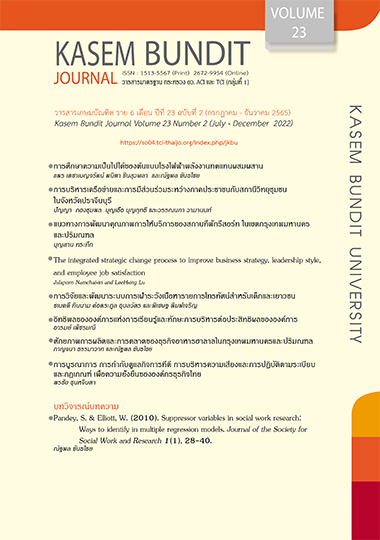The integrated strategic change process to improve business strategy, leadership style, and employee job satisfaction
Keywords:
Integrated strategic change, Likert’s management systems, Vroom-Yetton-Jago normative decision model, leadership style, job satisfactionAbstract
PURPOSES: To assess the current situation of ABC Management Company (Pre-Organization Development Intervention (Pre - ODI), to conduct Organization Development Intervention (ODI) based on Integrated Strategic Change (ISC), Strengths, Opportunities, Aspirations, and Results (SOARX, and Business Model Canvas frameworks, and to develop a business strategy that would serve the company’s long-term vision and corporate goals. METHODS: The researcher applied Likert organization characteristic survey questionnaires, job satisfaction survey, the Vroom-Yetton-Jago Normative Decision Model, leadership coaching, SOAR workshop, strategic planning workshops, and semi-structured interviews to collect the data. ODIs were applied to assess the top executives’ leadership style and employee job satisfaction. The study also included the assessment of the leadership style of the top executives at the Pre-ODI and Post-ODI stages. The participants were 2 top executives and 35 employees of the company. RESULTS: A statistically significant improvement from Pre-ODI to Post-ODI in top executives’ leadership styles and employee job satisfaction. ISC-ODI resulted in a new business strategy with the corresponding organizational structure and action plans co-created by all participating employees. THEORETICAL/POLICY IMPLICATION: Proposed new business strategy, organization structure and action plan could serve long – term company vision and goals of the company.
References
Alkhafaji, A. F. (2003). Strategic management: Formulation, implementation, and control in a dynamic environment. The Haworth Press, Inc.
Ching, H. Y., & Fauvel, C. (2013). Criticisms, variations, and experiences with business model canvas. European Journal of Agriculture and Forestry Research, 1(2), 26–37. https://citeseerx.ist.psu.edu/viewdoc/download;jsessionid=7A76F43B9AC2A88563176A1DFB21E986?doi=10.1.1.452.1207&rep=rep1&type=pdf
Cummings, T. G., & Worley, C. G. (2008). Organization development & change, 9th edition. South-Western Cengage Learning.
Osterwalder, A. (2004). The business model ontology is a proposition in a design science approach. http://www.hec.unil.ch/aosterwa/PhD/Osterwalder_PhD_BM_Ontology.pdf
Osterwalder, A., & Pigneur, Y. (2010). Business model generation: A handbook for visionaries, game changers, and challengers (The Strategyzer series). John Wiley & Sons, Inc.
Samosudova, N. V. (2017). Modern leadership and management methods for development organizations. MATEC Web of Conferences, 106, 08062. https://doi.org/10.1051/matecconf/201710608062
Stavros, J. M., & Cole, M. L. (2014). SOARing towards positive transformation and change. The ABAC ODI Journal, 1(2), 10–34.
Downloads
Published
How to Cite
Issue
Section
License
Copyright (c) 2022 KASEM BUNDIT JOURNAL

This work is licensed under a Creative Commons Attribution-NonCommercial-NoDerivatives 4.0 International License.
ทัศนคติ ความคิดเห็นใด ๆ ที่ปรากฏในวารสารเกษมบัณฑิตฉบับนี้เป็นของผู้เขียน โดยเฉพาะ มหาวิทยาลัยเกษมบัณฑิตและบรรณาธิการ ไม่จำเป็นต้องมีความเห็นพ้องด้วย







